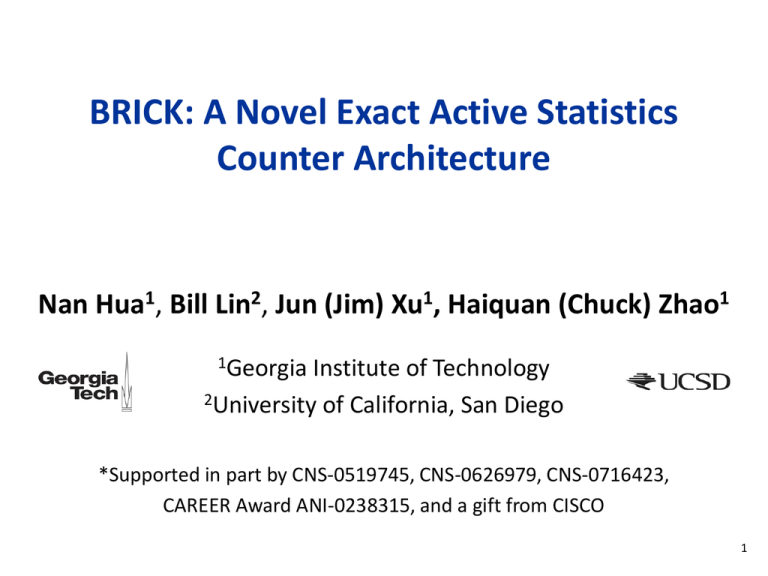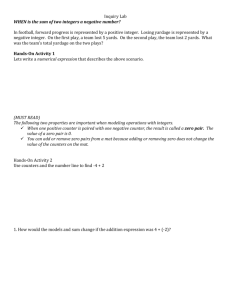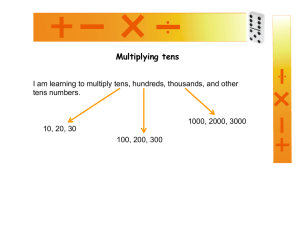BRICK: A Novel Exact Active Statistics Counter Architecture Nan Hua
advertisement

BRICK: A Novel Exact Active Statistics
Counter Architecture
Nan Hua1, Bill Lin2, Jun (Jim) Xu1, Haiquan (Chuck) Zhao1
1Georgia
Institute of Technology
2University of California, San Diego
*Supported in part by CNS-0519745, CNS-0626979, CNS-0716423,
CAREER Award ANI-0238315, and a gift from CISCO
1
Main Takeaways …
• We need exact “active” counters
– Be able to update and lookup counters at wirespeed
• Millions of full-size counters too expensive in SRAM
• We can store millions of counters in SRAM with an
efficient “variable-length” counter data structure
2
Motivation
• Routers need to maintain large arrays of per-flow
statistics counters at wirespeed
– Needed for various network measurement, router
management, traffic engineering, and data streaming
applications
– Millions of counters are needed for per-flow
measurements
– Large counters needed (e.g. 64 bits) for worst-case counts
during a measurement epoch
– At 40 Gb/s, just 8 ns for updates and lookups
3
Passive vs. Active Counters
• Passive counters:
– For collection of traffic statistics that are analyzed “offline”,
counters just need to be updated at wirespeed, but full
counter values generally do not need to be read frequently
(say not until the end of a measurement epoch)
• Active counters:
– However, a number of applications require active counters,
in which values may need to be read as frequently as they
are incremented, typically on a per packet basis
– e.g. in many data streaming applications, on each packet
arrival, values need to be read from some counters to
decide on actions that need to be taken
4
Previous Approaches
• Naïve “brute-force” SRAM approach
– Too expensive: e.g. 2 million flows x 64-bits = 128 Mbits =
16 MB of SRAM
• Exact passive counters
– Hybrid SRAM-DRAM architectures (Shah’02,
Ramabhadran’03, Roeder’04, Zhao’06)
– Interleaved DRAM architectures (Lin and Xu, 08)
– Counter braids (Lu et al, 08)
– Passive only: Counter lookups require many packet cycles
• Approximate counters
– Large errors possible: e.g. well over 100% error
5
Our Approach
• Main observations
– The total number of increments during a measurement
epoch is bounded by M cycles (e.g. M = 16 million cycles)
– Therefore, the sum of all N counters is also bounded by M
(e.g. N = 1 million counters)
N
SC
i
≤ M
i=1
– Although worst-case count can be M, the average count is
much smaller (e.g. M/N = 16, then average counter size
should be just log 16 = 4 bits)
6
Our Approach (cont’d)
• To exploit the fact that most counters will be small,
we propose a novel “Variable-Length Counter”
representation called BRICK, which stands for
Bucketized Rank-Indexed Counters
• Only dynamically increase counter size as necessary
• The result is an exact counter data structure that is
small enough for SRAM storage, enabling both
active and passive applications
7
Basic Idea
• Randomly bundle counters into buckets
• Statistically, the sum of counter sizes per bucket
should be similar
8
BRICK Wall Analogy
• Each row corresponds to a bucket
• Buckets should be statically sized to ensure a very
low probability of overflow
• Then provide a small amount of extra storage to
handle overflow cases
9
A Key Challenge and Our Approach
• The idea of variable-length data structures is not new,
but expensive memory pointers are typically used to
“chain” together different segments of a data
structure
• In the case of counters, these pointers are as or even
more expensive than the counters themselves!
• Our key idea is a novel indexing method called Rank
Indexing
10
Rank Indexing
• How rank indexing works?
– The location of the linked element is calculated by the
“rank” operation, rank(I, b), which returns the number of
bits set in bitmap I at or before position b
– No need for explicit pointer storage!
Bitmaps
rank(I1, 5) = 2
(it’s 2nd bit set in I1)
11
Rank Indexing
• Key observation: The rank operator can be
efficiently implemented in modern 64-bit x86
processors
• Specifically, both Intel and AMD x86 processors
provide a popcount instruction that returns the
number of 1’s in a 64-bit word
• The rank operator can be implemented in just 2
instructions using a bitwise-AND instruction and the
popcount instruction!
12
Dynamic Sizing
• Suppose we increment C2, which requires dynamic
expansion into A2
• The update is performed by performing a variable
shift operation in A2 , which is also efficiently
implemented with x86 hardware instructions
00000
rank(I1, 5) = 2
(it was 2nd bit set in I1)
rank(I1, 5) = 3
(it’s now 3rd bit set in I1)
13
Finding a Good Configuration
• We need to decide on the following for a good
configuration
–
–
–
–
k : the number of counters in each bucket
p : the number of sub-arrays in each bucket A1 … Ap
k1 … kp : the number of entries in each sub-array (k1 = k)
w1 … wp : the bit-width of each sub-array
• We purposely choose k = 64 so that the largest index
bitmap is 64-bits for the rank operation
• We purposely choose wi and ki so that wi * ki ≤ 64
bits so that shift can be implemented as a 64-bit
bitmap operation
14
Finding a Good Configuration (cont’d)
• Given a configuration, we can decide on the
probability of bucket overflow Pf using a binomial
distribution tail bound analysis
15
Tail Bound
N
• Due to the total count constraint
C
i 1
M
at most
2
w1 w2 ... wd 1
i
M
(defined as md )
counters would be expanded into the dth sub-array
• Translated into the language of “balls and bins”:
– Throwing md balls into N bins
– The capacity of each bin is only kd
– Bound the probability that more than Jd bins have more
than kd balls
• The paper provides the math details to handle
correlations
16
Numerical Results
• Sub-counter array sizing and per-counter storage for
k = 64 and Pf = 10-10
17
Simulation of Real Traces
• USC (18.9 million packets, 1.1 million flows) and UNC
traces (32.6 million packets, 1.24 million flows)
Percentage of full-size buckets
18
Trends
19
Trends
20
Concluding Remarks
• Proposed an efficient variable-length counter data
structure called BRICK that can implement exact
statistics counters
• Avoids explicit pointer storage by means of a novel
rank indexing method
• Bucketization enables statistical multiplexing
21
Thank You
22
Backup
23
Tail Bound
N
• Due to the total count constraint
C
i 1
M
at most
2
w1 w2 ... wd 1
i
M
(defined as md )
counters would be expanded into the dth sub-array
• Translated into the language of “balls and bins”:
– Throwing md balls into N bins
– The capacity of each bin is only kd
– Bound the probability that more than Jd bins have more
than kd balls
24
Tail Bound (cont’d)
• Random Variable Xi(m) denotes the number of balls thrown
into the ith bin, when there comes m balls in total
h
• The failure probability is Pr[1 ( m ) J ]
{ X c}
j 1
j
(J is the number of full-size buckets pre-allocated)
• We could “estimate” the failure probability this way:
– The overflow probability from one bin is
(Binotail is tail probability
ò Binotailk ,m / N (c )
of Binomial distribution)
– Then the total failure probability would be
Binotailh ,ò ( J )
– This calculation is not strict since Random Variable Xi(m)s are
correlated under the constraint (although weakly)
25
Tail Bound (cont’d)
• How to “de-correlate” the weakly correlated Xi(m) ?
• Construct Random Variables Yi(m) , i=1….h, which is i.i.d
random variables with Binomial distribution (k,m/N) .
• it could be proved that:
E[ f ( X 1( m ) ,, X h( m ) )] 2 E[ f (Y1( m ) , , Yh( m ) )]
where f is an nonnegative and increasing function.
• Then, we could use the following increasing indicator function
to get the bound
f ( x1 ,, xh ) 1
h
1{ xi c } J
i 1
26
Effects of Larger Buckets
• Bucket size k = 64 works well, amenable to 64-bit
processor instructions
27



